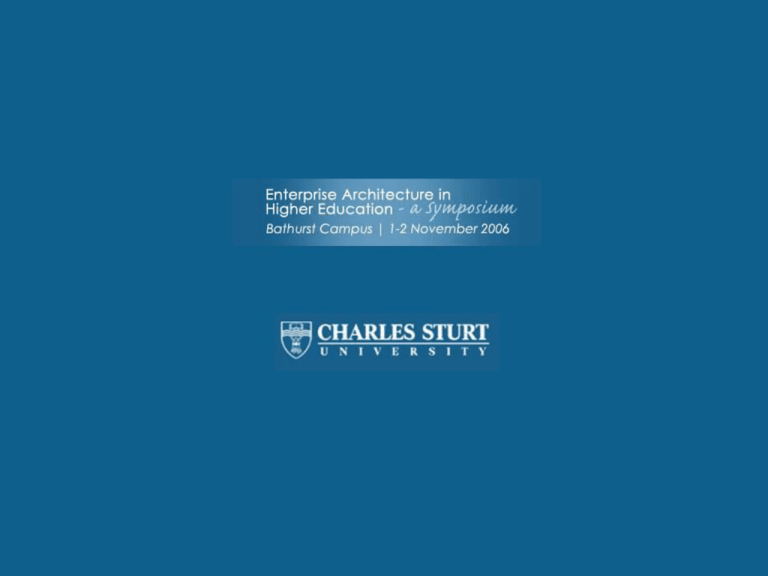Download ' Enterprise Architecture at Curtin University ' .ppt (480KB) >
advertisement

Enterprise Architecture at Curtin University Maureen Murray Why did we need it? Good ideas acted on independently Duplication of projects and infrastructure “Solutions” rather than strategies No common standards Projects not connected to what we were doing IT driven How will we use it? The architecture provides a framework for: Investment decisions Evaluation and prioritisation of projects Design and development of systems and infrastructure Evaluation and acquisition Management and use of assets, including data How did we go about it? Developed and agreed a framework Did lots of research, developed from first principles Guiding principle was “How are we going to use it?” Added detail to the framework Kept it simple, limited detail Already had lots of stuff Challenges Resources Hard to get IT people involved Hard to get IT staff to “abstract” Hard to justify our approach Hard to get people to contribute Curtin’s Enterprise Architecture Framework Business Context Guidelines and Design Principles Enterprise Information Architecture Systems Architecture Technical Architecture Research Collaborators Community Prospective Staff Students Students Competition Social Climate States the business strategy, the services provided by the university and the information required to meet the objectives of the university Strategic Plans Defines how information is used and managed through its lifecycle to support the business Defines the systems that store and manage the information Defines the infrastructure required to support the systems and the business Emerging Technology CHANGE Policy/Legislation Partners Economic Climate Business Context Information Architecture Systems Architecture Technical Architecture Industry Alumni Business Context Business Guidelines and Principles Business Environment ICT Strategies to Meet Business Objectives Business Architecture Business Architecture Clients Students, Staff, Alumni, Prospective Students, Research Collaborators, Partners, Community, Industry, Vendors/Suppliers User Interface Applications Portal Face-to-Face Mobile Devices Websites Publications Correspondence Learning Support Communication Teaching Support Marketing & Public Relations Staff Management Financial Management Student Support Payroll Planning Relationship Management Facilities Management Procurement Information Service ICT Support Data and Integration Layer Student Information Research Information Identity Information Learning Information Client Relationship Information Facilities Information Marketing Information Finance Information Staff Information Scholarly Information Procurement Information ICT Support Information Governance Research & Development Security and Identity Management Business Services ICT Enterprise Guidelines and Design Principles Information systems for business needs Shared access Defined authoritative sources Secure information Proven standards and technology Lifecycle cost Agility Allow exceptions sometimes Enterprise Information Architecture Information Guidelines and Principles Classification and Categorisation Unstructured Content Structured Data Information Management Strategy User Interfaces Business Processes, Reporting, Business Intelligence Analytics Information Integration Data Quality Data and System Integration Content Management Metadata Management Taxonomy Data Files Web Pages DB Data warehouse DB Document Repositories Email Store Security Unstructured Content Collaboration Structured Data Information Quality processes / standards Enterprise Search Systems Architecture Objectives of the architecture Business Systems and Services Recommended Architecture N-tier Web services and web enabled Standards for integration/interoperability SOA Business Systems and Services Business Services Research & Development Learning Support Communication Teaching Support Staff Management Marketing & Public Relations Financial Management Student Support Payroll Facilities Management Planning Relationship Management Procurement Information Service ICT Support Student Systems Facilities Management Systems Finance System Library Systems Productivity Software ICT Service Management Systems Marketing and CRM Systems Purchasing Systems Research Systems Planning Systems Communication Systems Learning Management Systems Data and Integration Layer Student Information Research Information Identity Information Learning Information Client Relationship Information Facilities Information Marketing Information Finance Information Staff Information Scholarly Information Procurement Information ICT Support Information Human Resources Systems Governance Management Reporting System Security and Identity Management Software Systems Technical Architecture Objectives of the architecture Key technology strategies to achieve objectives Recommended Architecture Virtualisation Advanced use of storage technology Use of clustered commodity servers Capacity management Appendix containing more technical information Technical Architecture User Interface (desktop, web browser, mobile device) Applications and Systems Services Middleware and Database Support and Services Hosting, Operating Systems Support and Services Technology architecture Agin g Technology life Cycle Planning Tier 2 Servers Agin g Tier 1 Servers IMS Storage Services (FIBRE channel, iSCSI, NAS) SAN Management Services and capabilities Agile Switch/DR of Applications between Nodes SAN Disaster recovery/Remote mirroring/capacity on Demand Network and Operations (computer room) Services Security and Access Tier 3 Servers Capacity Planning and Measurement Compute Services and Capabilties Policy/ Compliance/ Governance and Process Virtualisation and Clustering Services Security and IM User Interfaces Authentication, authorisation Business processes and policies Software Systems Limit access through menu system Authentication/Access controls Anti-spam, anti-virus Storage Layer Backup regime Access controls Network Secure protocols/VPN/Vlans Firewall/Intrusion Detection Systems Content filtering/monitoring Identity Management Governance and Audit Server Layer Access Controls Antivirus/Patch management Business Continuity/Disaster Recovery/High Availability Physical Security Data Layer Firewall Encryption File management Database privileges Auditing Where to from here? Need to develop a governance framework Distribute it widely and educate the university Start using it and see if it works Identify the next steps in further development of the architecture What did we learn?? Need to develop an information management strategy Technical areas need to focus on services rather than technologies Don’t document for the sake of it It will never be finished!!




